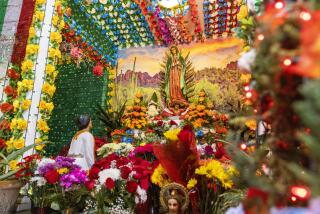HEARTS of the CITY / Exploring attitudes and issues behind the news : Swallowing the Truth at Capistrano
Here’s the plain truth about the swallows at San Juan Capistrano: They fly up from South America. They arrive sometime in the spring. In the fall, they fly back.
All else is lies. Or, more correctly, what historian Arnold Toynbee once called the “small, sweet lies of history.” By that, he meant the assortment of legends, minor frauds and life-enhancing myths that get attached to the histories of virtually every region.
So, do the swallows really return on the traditional swallow day of March 19, otherwise known as St. Joseph’s Day? Nah. Do they pick the 219-year-old Mission at San Juan Capistrano as their favorite roosting spot? Nah. Do the swallows come with little olive branches in their beaks; does the mission wait to ring its bell until the first swallow is spotted; do the swallows really have pretty split tails like the tourist signs want you to believe? Nah, nah, nah.
All lies, but sweet ones. The tradition of the swallows at Capistrano probably has lent more fun to more spring days than any legend in Southern California. That’s because, as legends go, the swallows have few competitors here. Mostly, the towns of Southern California like to pretend they have no history, and without history they can’t have legends.
Thus a recent unpleasantness in San Juan Capistrano bears some attention. For six weeks now, the town has agonized over a major tampering with the legend of the swallows. The citizenry has divided into camps, with each side genteelly accusing the other of hypocrisy. No one knows where it will end.
In fact, no one is certain exactly when it started. At some point last fall, the officials at the Mission of San Juan Capistrano decided they would change the date of the swallows’ famous return. Instead of March 19, the mission would celebrate on the 16th.
*
Why change the date? Simple. The traditional date of the 19th falls on Tuesday. The 16th happens to be a Saturday. The expected flock of tourists to Capistrano would grow by several orders of magnitude if the mission rang its bells welcoming the swallows on a Saturday rather than a Tuesday.
One estimate projected a weekday crowd at 5,000 and a weekend crowd at 20,000. Clearly, more people would be able to enjoy the celebration on a weekend. Just as clearly, the new date would increase revenues at the mission, which charges $4 for adult admission. Ditto for Capistrano’s restaurants and shops.
In part, then, the mission had made a decision in favor of mammon. But so what? The old date of St. Joseph’s Day, after all, represented a fraud. The swallows no more arrive on St. Joseph’s Day than any other day in mid-March. How could anyone rise up to defend this small, sweet lie?
As it turned out, the town had no problem rising to the defense. Within days of the news leaking out, the mission found itself deluged with calls. Janice Evans, an optometrist’s assistant, went out and printed--at her own expense--several hundred bumper stickers reading, “The Swallows Aren’t the Only Ones Who Don’t Like Changes! Celebrate St. Joseph’s Day, March 19th.” You can now see them riding around town on various vehicles.
Mary Tryon, a member of the local historical society, also found herself manning the barricades. “You don’t take something that people have honored for years and turn it into a commercial enterprise,” she says. “It gets robbed of its meaning.”
Tryon and her husband, Donald, seem to enjoy savoring the details of what they call the town’s legend. As far as they know, it first appeared in a book published in 1930 titled “Capistrano Nights, Tales of a California Mission Town.”
The book relates the story of Father John O’Sullivan, who found himself passing a new hotel in town during the 1920s. Outside the hotel the owner was smashing the swallows’ mud nests that had been built under the eaves.
Asked why he was destroying the nests, the owner said the birds were a nuisance.
“But where can they go?” the father asked.
“I don’t know, and I don’t care,” the owner replied.
“Then come on, swallows,” the father said, “I’ll give you shelter. Come to the mission, there’s room for all!”
According to the tale, the swallows took the father at his word and flocked to the sacristy of the mission’s church. “By the way,” O’Sullivan says in the book, “there is a rather odd fact about these swallows. You know, their return is with the greatest regularity on St. Joseph’s day, the 19th of March.”
*
Still, no one much noticed until news of the swallows’ amazing punctuality fell into the hands of a columnist at none other than the Los Angeles Times. Most likely desperate for material that day, he decided to give the swallows a plug.
Within days, a radio network picked up the item and decided to plant a crew at the mission for a daylong show. They broadcast the event to a nationwide audience, and the rest, as they say, is history. “Even the governor showed up for the broadcast,” said Donald Tryon.
As of this writing, the Tryons and other critics of the mission’s plan appear to have the momentum. Last week, mission officials announced that the celebration would be held on both days, and the bells would ring on both days. The offer salved the wounds somewhat, and the critics say they will now fight for full restoration of the 19th at next year’s festival.
“I want to hear the bells ring on the 19th and no other day,” said Tony Forster, another critic and former mayor of the town. “That’s the only thing that will satisfy me.”
Does it matter to the rest of us? Probably not. What matters is that San Juan Capistrano cared enough about its past, however whimsical and fraudulent, to fight for it. In doing so, they won the real war, whenever the swallows return, whenever the bells ring.
More to Read
Sign up for The Wild
We’ll help you find the best places to hike, bike and run, as well as the perfect silent spots for meditation and yoga.
You may occasionally receive promotional content from the Los Angeles Times.






